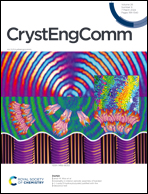Uranyl ion coordination polymers with the dibenzobarrelene-based rac- and (R,R)-trans-9,10-dihydro-9,10-ethanoanthracene-11,12-dicarboxylate ligands†
Abstract
trans-9,10-Dihydro-9,10-ethanoanthracene-11,12-dicarboxylic acid (deadcH2), in its racemic or R,R enantiomeric forms, has been used to synthesize eight uranyl ion complexes under solvo-hydrothermal conditions. [UO2(deadc)]·1.5CH3CN (1) and [H2NMe2]2[(UO2)2(deadc)3]·2H2O (2) crystallize as monoperiodic coordination polymers in which deadc2− forms both 4- and 7-membered chelate rings. Although synthesized in the same conditions as 2, the enantiomerically pure complex [H2NMe2]4[(UO2)2(O)(R,R-deadc)2]2 (3) is a discrete tetranuclear complex containing two μ3-oxo anions. Association with the zwitterion Ni(tpyc)2, where tpyc− is 2,2′:6′,2′′-terpyridine-4′-carboxylate, gives [(UO2)2(deadc)(deadcH)(NO3)Ni(tpyc)2]·CH3CN·2H2O (4), a rake-shaped monoperiodic assembly. [UO2(deadc)(DMA)] (5), [UO2(deadc)] (6) and [PPh4]2[(UO2)2(R,R-deadc)3] (7) crystallize as diperiodic networks with the fes, sql and hcb topologies, respectively, the thick layers formed being coated on both sides by protruding, hydrophobic dibenzobarrelene groups. Finally, [(UO2)2Ag2(deadc)3(CH3CN)2]·0.5H2O (8) contains monoperiodic uranyl–deadc2− subunits which are assembled into a triperiodic framework by bridging silver(I) cations, the latter interacting with both carboxylate groups and aromatic rings. Except for 6, all these complexes are emissive with photoluminescence quantum yields of 2–26%, and most spectra display the usual vibronic fine structure of uranyl emission.



 Please wait while we load your content...
Please wait while we load your content...